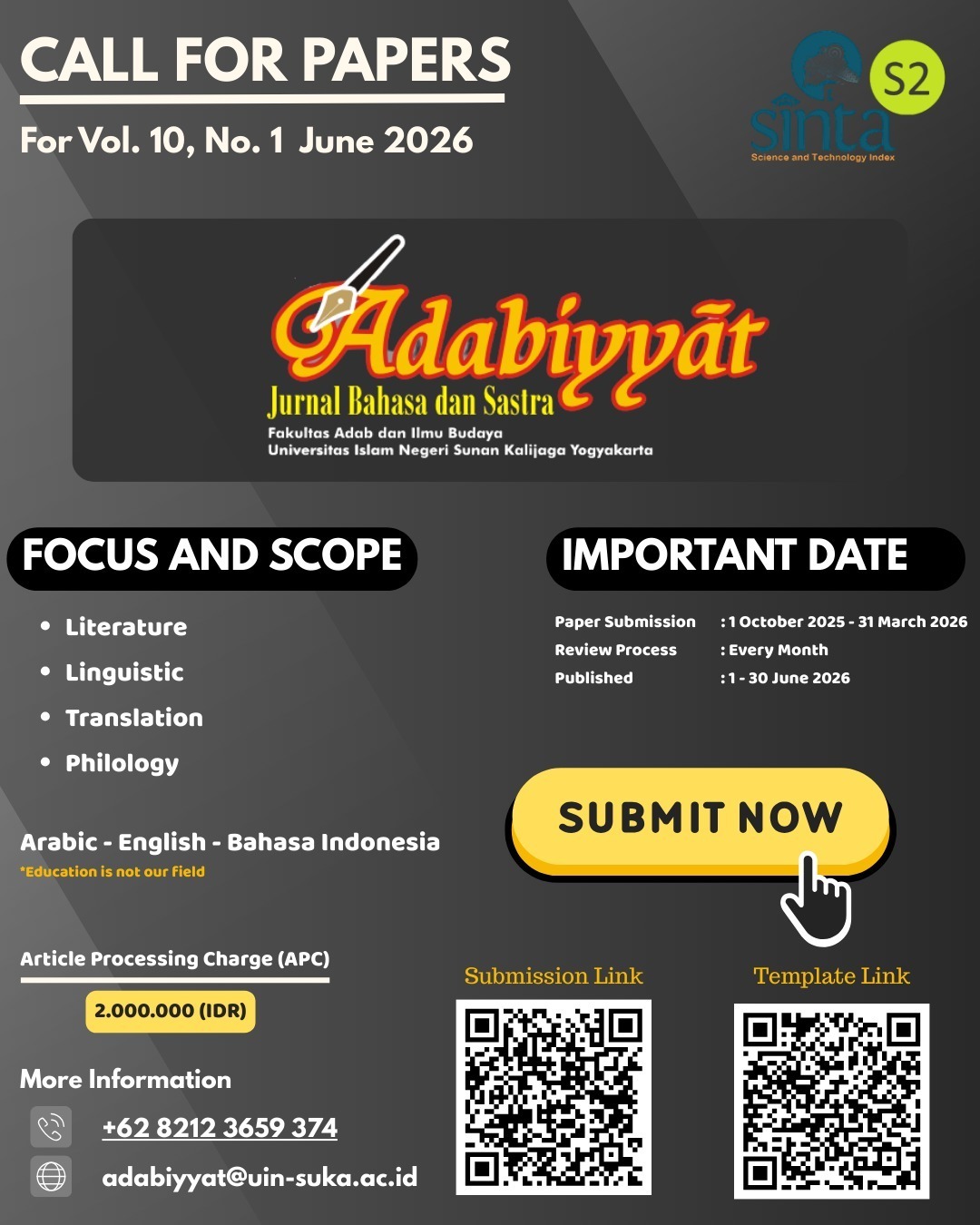BAHASA ARAB SEBAGAI BAHASA DIGLOSIS
DOI:
https://doi.org/10.14421/ajbs.2009.08102الملخص
Just like many centuries ago, the Arabic language today is under a “diglossic” situation. As a langue, it richly varies that among them are the “high” and the “low” –something that very common in a diglossic situation. The “high” is the formal variant, called fushā and the “low” is the colloquial spoken variant, called lahjah (dialect). This latest variant grows differently in many shapes that are not yet clearly classified as the linguists agree so far. The dichotomy between fushā-lahjah truly is not a new phenomenon in Arabic world as it has taken place since long ago. However, it has just become a serious problem lately. The dialectical Arabic growth of the lahjah with its plenty different variants in the centers of culture raises problems. This paper comes before you describing the general situation instead of the detail characteristic of every variant. Besides, herewith the discussion on the scientific attention on the matter of diglossic Arabic and —certainly— the problems it rises. The Arabic linguists pay so much attention to solve it for which the debates come largely. The unavoidable disagreements come into one of the three: keeping the fushā, contradicting it, or standing between. Some opinions are given for examples. However all out they have made their effort for it, it would remain a difficult problem without a serious consideration of all the Arab Unity on their own language. Therefore, the involvement of all of the Arabic states is absolutely needed.
التنزيلات
المراجع
Al-Khūliy, Amīn. 1965. Musykilāt H_ ayātinā al-Lugawiyyah. Kairo: Dār al-Ma’rifah.
Al-Zarkāni, Muhammad ‘Ali. 1997. Al-Juhūd al-Lugawiyyah. Damaskus: Mansyūrāt Ittih_ ād al-Kuttāb al-‘Arab.
Anīs, Ibrahim. 2003. Min Asrār al-Lugah. Cet. VIII. Kairo: Maktabah al-Enjelo al-Mis_ riyyah,
Applied Language. 2009. “Spoken or Colloquial Arabic”. Dalam http://www.appliedlanguage.com/languages/arabic/spoken_arabic.shtml, diakses tanggal 1 Maret 2009.
Belkin, V. M.. 1960. “The Problem of Literary Language and Dialect in Arabic Countries.” Problems of The Formation and Development of National Language, ed. Guxman, M.M., terj. oleh Kathleen Lewis. T.tp.
Bint Syāti’, ‘Āisyah. 1971. Lugatunā wa al-H_ ayāh. Cet. II. Maroko: Dār al-Ma’ārif. Chejne, Anwar. G. 1994. Bahasa Arab dan Peranannya dalam Sejarah, terj. oleh Aliudin Mahjudin. Jakarta: Pusat Pembinaan dan Pengembangan Bahasa.
Daud, Muhammad Muhammad. 2006. Lugawiyyāt Muhdasah. Kairo: Dār Gharib.
Diab, Mona dan Nizar Habash. 2009. “Arabic Dialect Processing Tutorial”. Dalam http:www.mt.archiveinfo/NAACL-HLT2007-Diab.pdf, diakses tanggal 1 Maret 2009.
El-Helaby, Lamya. 2009. “The Diglossic Situation in Saudi Arabia”. Dalam readingcall.com/files/The_Diglossic_Situation_in_Saudi_Arabia.33065151.doc, diakses tanggal 1 Maret 2009.
Ferguson, C. A. 1975. “Diglosia”. Language and Context. ed. Pier Paolo Giglioli. London: Penguin Education.
Hitti, Philips K. 2005. History of the Arab. Terj. oleh R. Cecep Lukmana Yasin dan Dedi Slamet Riyadi. Jakarta: Serambi.
Lumbrosso, Jacob. 2009. “The Variety of Arabic Dialects”. Dalam http://elt-bahrain. blogspot.com/2008/06/variety-ofarabic-dialects.html, diakses tanggal 10 Maret 2009.
Maxos, Hussein. 2009. “Problems of Spoken-Written Arabic”. Dalam http:// hmaxos.com, diakses tanggal 1 Februari 2009.
Schulz, Eckehard. 2006. Buku Pelajaran Bahasa Arab Baku dan Modern. Versi bahasa Indonesia oleh Esie HartiantyHanstein dan Thoraf Hanstein. T.tp.
Sumarsono dan Paina Partana. 2002. Sosiolinguistik. Yogyakarta: Sabda dan Pustaka Pelajar.
Translation Company [Beijing Translation Company]. 2009 “About Language, Arabic”. Dalam http://www.bjtranslate. com/ arabic.asp, diakses tanggal 1 Maret 2009.
Versteegh, Kees. 1997. Landmarks in Linguistic Thought III. London: Routledge.
_______. 1997. The Arabic Language. New York: Columbia University Press.
التنزيلات
منشور
إصدار
القسم
الرخصة
- Adabiyyāt: Jurnal Bahasa dan Sastra publishes all articles entirely in full text.
- It is permissible for readers to download and to use it for scientific purposes and scientific dissemination.
- The author can re-publish the article that has been published by the Adabiyyāt: Jurnal Bahasa dan Sastra after obtaining written permission from the editor. This letter can be obtained by submitting a request letter for permission to republish the article to Adabiyyāt: Jurnal Bahasa dan Sastra via email adabiyyat@uin-suka.ac.id. In the second publication, the author is required to include information that the article was firstly published by the Adabiyyāt: Jurnal Bahasa dan Sastra.




















